Last Chance to Catch NYC's Holiday Notalgia Train
We met the voices of the NYC subway on our nostalgia ride this weekend!


Strategically placed along the waterways surrounding New York City to warn of aquatic hazards, a collection of lighthouses ushers ships into New York Harbor, lighting the way for a safe passage into what was once one of the busiest ports in the world.
In the early 19th-century, as New York City and the United States began to rapidly grow and gain power on a global scale, New York Harbor and the Lower Bay leading into it saw a dramatic increase in maritime traffic. There arose a need for navigational aids to warn ships of the dangers in the water and to guide them safely to shore.
Today, sadly, many of the beautifully designed lighthouses of this time have been lost, replaced with skinny, skeletal metal towers, but still others have been able to bear the test of time. Untapped New York recently took a tour of the Ambrose Channel, a shipping channel which runs from south of the Verrazano Bridge, the gateway to New York Harbor, along the coasts of New Jersey, Staten Island, and Long Island to Manhattan, with The National Lighthouse Museum. On the tour we discovered many historic lighthouses around New York City that hold more stories than just those of shipping and trade.
In this list of historic lighthouses, functional and not, for show and for navigation, discover the stories of the people who lived in and ran them, the origins of their designs, and what their place is in on our modern waterways.

One of the first lighthouses you will see aboard the The National Lighthouse Museum‘s Ambrose Channel cruise is the Coney Island Lighthouse. The lighthouse was erected in 1890 at the western end of Brooklyn in an area formerly known as Norton’s Point. The white tower stands near sixty-one feet tall with a blinking red light at the top which warns of the rocks of Gravesend Bay at the Narrows. Today, the lighthouse is part of the gated community of Sea Gate, a far cry from the seedy spot it was around the time the lighthouse was built. Along with the original tower, which was built using plans for the Throg’s Neck lighthouse, the site also has an adjoining keeper’s house and storage shed.
The lighthouse is most famous for its dedicated keeper Frank Schubert. Schubert, who was America’s last civilian lighthouse keeper, served at the Coney Island Lighthouse from 1960 until his death at the age of 88 in 2003. Schubert spent his life on boats and near the sea. He joined the Coast Guard Lighthouse Service in 1939 and tended lighthouses throughout his entire life. He lived at the Coney Island with his wife and children for forty-three years.
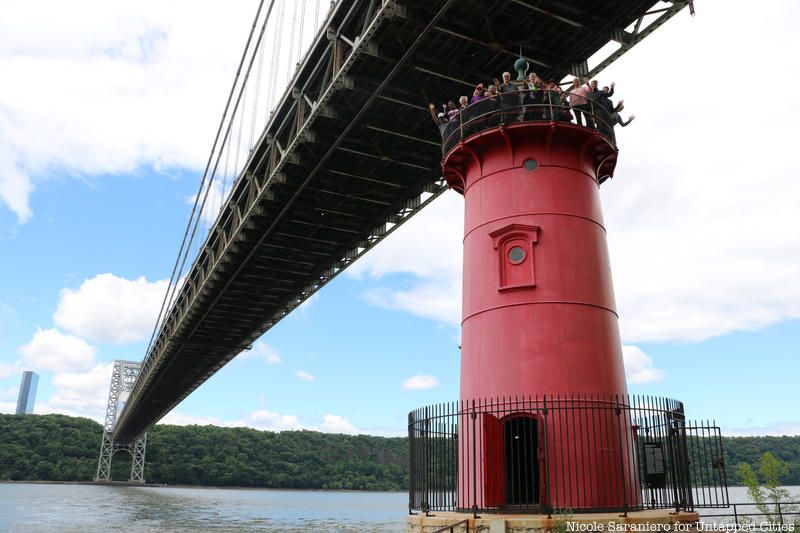
The Little Red Lighthouse is perhaps one of New York City’s most famous. The vibrantly colored beacon sits underneath the George Washington Bridge in Fort Washington Park on the shore of the Hudson River. Officially named the Jeffery’s Hook Lighthouse, it was originally erected across the river in New Jersey in 1880 then moved its current location in 1921. The 40-foot tall structure has 48 cast-iron steps inside which will take you all the way to the top for stunning views of the New York skyline and the Hudson River. Though its color is its most famous feature, the lighthouse wasn’t always red, and no one knows exactly when or why it was painted!
The Little Red Lighthouse found its way into the heart’s of New Yorkers in 1942 when writers Hildegarde Swift and Lynd Ward published The Little Red Lighthouse and the Great Gray Bridge. In 1931, the completion of the bridge made the lighthouse obsolete and the Coast Guard planned to demolish it. The book helped to endear the little lighthouse to the public who ultimately saved the lighthouse. It is currently run by the NYC Parks Department and you can go inside and climb to the top on our Untapped New York Insider tours!

The ominously named Execution Rocks Lighthouse sits on a rocky stretch of reef in the Long Island Sound, not far from City Island and Hart Island in the Bronx. Legend has it that the moniker comes from executions carried out on the island by the British before the American Revolution. The British allegedly would chained prisoners to the rocks at low tide and let them drown when high tide came in, but there is no evidence to support this. The official origin story of the name comes from the treacherous, rocky terrain of the area which has led to many boats being “executed” as they tried to pass.
The light house was designed by architect Alexander Parris, who also built Boston’s St. Paul’s Cathedral and Quincy Market, and placed on the largest rock of the reef. Granite for the construction of the fifty-eight foot tower and accompanying keeper’s home was quarried from Manhattan at the site of excavation for the construction of the Hotel Continental, located at Broadway and 41st Street. The lighthouse became active in 1850 and was manned until December 1979 when it became automated. In 2007 the Coast Guard offered the site to eligible organizations through the National Historic Lighthouse Preservation Act of 2000 which allowed for Federally-owned historic light stations deemed excess to be transferred at no cost to Federal agencies, State and local governments, nonprofit corporations, educational agencies, and community development organizations. Two years later, Historically Significant Structures received the deed for the lighthouse for just $1, since there were no other bidders. Today, you can tour the lighthouse on a day trip, stay overnight, or even host an event there.

You’ll find another highlight of the Ambrose Channel tour in Lower New York Harbor, the Romer Shoal Lighthouse, a landmarked structure placed at its current location in 1898. Before becoming a beacon in the water the steel structure was used at the Staten Island Lighthouse Depot to test fuel, wicks, bulbs and other equipment. Before the lighthouse was moved to its current spot, two other structures marked the location of the dangerous shoal, or hidden ridge, beneath the water. The Romer part of the name has been contested, though the most likely story is that it was named after Wolfgang William Romer, a Dutch military engineer and cartographer who mapped New York’s waterways in the 18th-century.
The lighthouse was manned by a crew of three men while in operation. It was automated in 1966. After a severe storm caused damage to the lighthouse in 1992, the Coast Guard wanted to replace it but Joe Esposito, keeper of the Staten Island Lighthouse at the time, wouldn’t allow it. In 2011 the lighthouse was put up for auction and purchased by John Scalia. The lighthouse has sentimental value to Scalia who grew up looking at it from his home on Staten Island. It was also the first structure his immigrant parents saw as they journeyed to Ellis Island. Today, Scalia leads an organization of “Romer Keepers” who are working to restore the lighthouse which has sustained significant damage from the passage of time and storms like Superstorm Sandy.
The Staten Island Range Light is an example of a rare land-locked lighthouse. Located four miles from the nearest coastline, it serves as the rear range lighthouse for the West Bank Lighthouse five miles to the southeast. It is situated within the neighborhood of Lighthouse Hill and is nearby “Crimson Beech,” the only home designed by Frank Lloyd Wright in New York City. The light tower is uniquely picturesque with a construction of brick with stone trimming, a red light and iron balcony.
The Lighthouse began operations in 1912, though most of the structure was completed by 1909, and work continued until 1915. In 1992, local resident, lighthouse enthusiast and historian Joe Esposito volunteered to be the caretaker of the light and served as such until 2001. The light is still in use today, guiding ships through the Ambrose Channel, and the keeper’s house is a private residence.
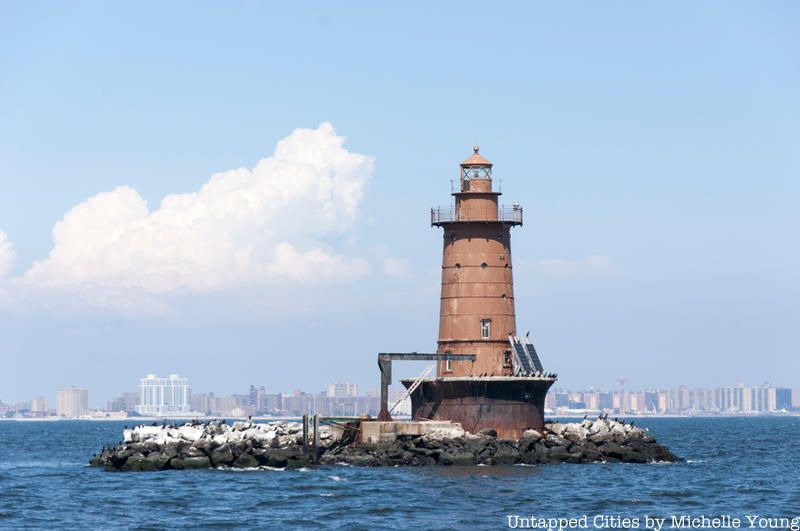
Sitting on the west side of the Ambrose Channel, the West Bank Lighthouse has been warning vessels of hazardous sandbars since 1901. Construction lasted only six months on the metal lighthouse which is made of iron from the West Side Foundry of Watervliet, New York. The lighthouse was designated as surplus by the United States Department of the Interior in 2007 and went up for auction in 2010. The winning bidder was Sheridan Reilly, a boater who had sailed past the lighthouse many times and felt it was his duty to save it in order to compensate for all the lives saved by the Light.
In its more than 100 years of service, the light house has sustained some occupational injuries. In 1904 during a heavy storm the vessel Carrie Winslow, which was being towed by a tugboat, crashed into the lighthouse and took with it a chunk of metal and railings. Again in 1915, a barge being towed crashed into the lighthouse and ripped off part of the base. The final incident occurred in 1973 when a vessel ran into the riprap and scared the keeper Robert Lyons so much that he slept with a life jacket nearby from then on. Around that same time, another curious incident occurred. One morning while Lyons was watching television a couple of boys and girls walked into the lighthouse, expecting it to abandoned like others they said they had visited. Lyons proceeded to give them a tour of the very much occupied and active light house.
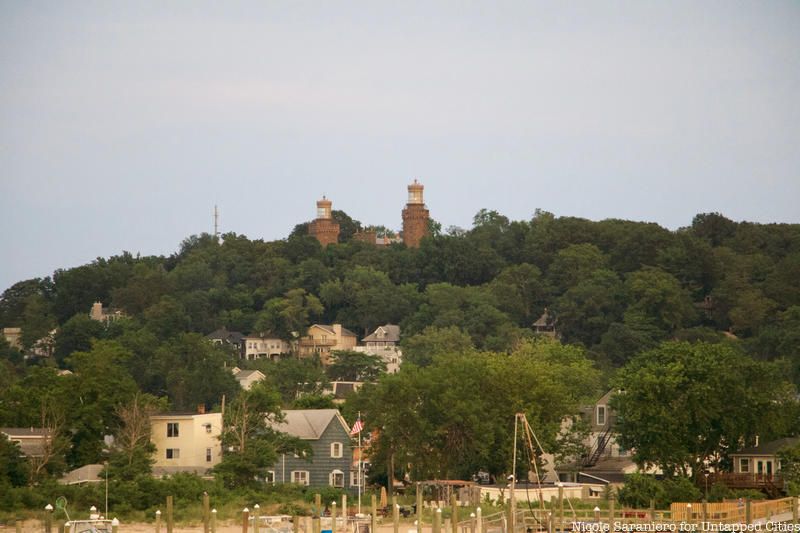
The Navesink Twin Lights are not exactly twins anymore, but they used to be. Situated high in the Navesink Highlands of New Jersey, where you will find some of the tallest peaks along the eastern seaboard, the original twin lights, as they were called by keepers and sailors, looked out over Sandy Hook Bay. Constructed in the 1820s, the identical octagonal towers were made of blue split stone and separated by 320 feet with a wooden house in the middle. In 1841, the twin lights became the first lighthouse lights in America to be outfitted with Fresnel lenses, a special lens created by French physicist Augustin-Jean Fresnel.
By the 1860s, due to poor materials and shoddy workmanship, the lighthouse was in a sad state. Money was approved for improvements to the lighthouse and in 1862 the new Twin Light structure went on duty. The design of the new structure was created by architect Joseph Lederle and inspired by the Smithsonian Castle in Washington, D.C. The castle-like structure is made of brownstone quarried from New Jersey and has two mismatched towers, the tower to the north is octagonal tower and the tower to the south, 228 feet away, is square. They are connected by a two-story residence for the principal keeper and his first assistant and jutting off of each tower on either end there is living space for other assistant keepers, workshops and oil rooms.
The lighthouse, in addition to being historic in the evolution of lighthouses in the country, played host to a number of other historic events and technological breakthroughs. In 1893 the lighthouse hosted the first official reading of the Pledge of Allegiance as America’s national oath of loyalty, an event that coincided with the opening of the World’s Fair in Chicago. The ceremony was held around the lighthouse’s 135-foot Liberty Pole, the first piece of America millions of immigrants saw on their way to Ellis Island in the 19th century. In 1899, the lighthouse witnessed history again when inventor Guglielmo Marconi transmitted wireless messages from a boat offshore to a New York newspaper for publication. Breakthroughs were also made here in radar technology, an innovation which was integral to Allied success in World War II.

Located near the eastern tip of the peninsula below Sheepshead Bay in Manhattan Beach, the Kingsborough Lighthouse is the newest lighthouse in New York City. Built by the Coast Guard in 1990 and originally named the Marine and Academic Center, or MAC, the structure is part of the Kingsborough Community College campus. The flashing white light beams outward from 114 feet above sea level and shines out eleven miles.
The light is housed in a metal point at the top of a building which serves as space for classes and conferences, as well as cultural events and performances as part of On Stage at Kingsborough programming. One of the most popular series hosted at the site is the annual series of intimate jazz concerts, Jazz at the Lighthouse. With floor to ceiling windows which look out to the water, the lighthouse is a great place to enjoy a show.
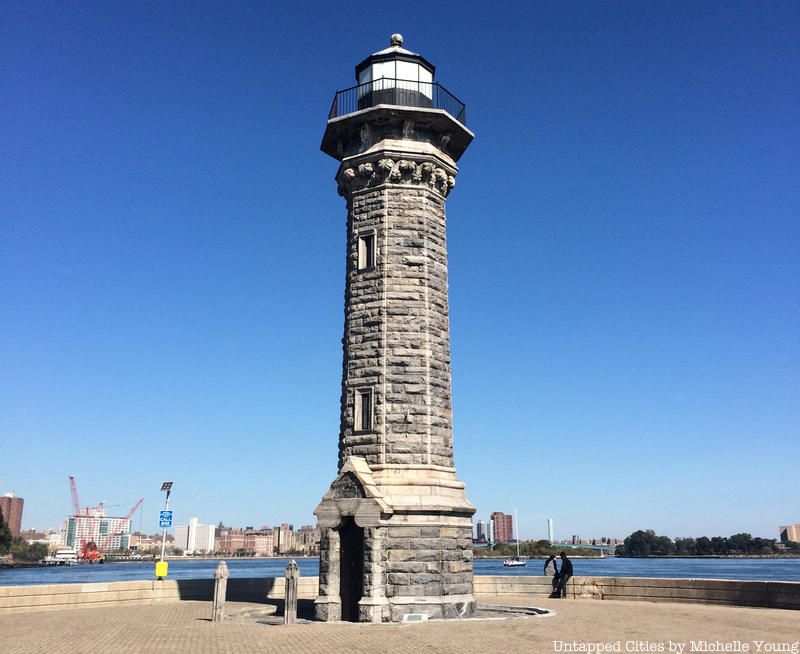
The Blackwell Island Lighthouse is a mysterious remnant of Roosevelt Island’s distant past. Before the slender East River island came to be owned by the city in the 1920s, it was owned by the Blackwell family and hence bore the family name. The lighthouse was commissioned by the city, not the Coast Guard, in 1872. The private tower was meant to help illuminate the New York City Insane Asylum for incoming boats. James Renwick, Jr., the architect of the island’s nearby Smallpox Hospital (which still stands in ruins) and St. Patrick’s Cathedral, designed the tower and it is likely that patients were used for labor.
The mystery which surrounds the lighthouse is that of two possible asylum inmates whose names are associated with it. Legend says that before the lighthouse was constructed, asylum patient John McCarthy was building a clay fort to defend against British invasion on the site. When the lighthouse was to be built, his fort was destroyed. Supposedly what happened next was that another patient, Thomas Maxey, a self-styled architect, mason, carpenter, civil engineer, philosopher, and philanthropist built the lighthouse tower. Despite this version of events, a plaque at the lighthouse’s base, which disappeared in the 1960s, credited the lighthouse construction to McCarthy, leading historians to conjecture that either Maxey and McCarthy were the same person or that neither ever even existed.
The lighthouse was decommissioned in the 1940s and became a landmark in the 1970s. Today the site is run by the NYC Parks Department. The grounds surrounding the tower are open to the public but the lighthouse tower remains closed.

The Titanic Memorial Lighthouse is one of the many maritime memorials you can find scattered throughout New York City and also one of the many remnants of the Titanic’s ill-fated voyage. The 60-foot tall Titanic Memorial Lighthouse and Time Ball was dedicated to the victims of the tragedy and mounted to the top of the Seamen’s Church Institute at 25 Water Street in 1913. Everyday at noon from the time of its installation until 1967 the Titanic time ball received a telegraphic signal from the Naval Observatory in Washington D.C and dropped halfway down the pole to indicate that the time was 12pm. Every evening the lighthouse shone a bright green light.
In July 1968, when the Seamen’s Church Institute moved to 15 State Street, the Titanic Memorial Lighthouse was donated to the South Street Seaport Museum by the Kaiser-Nelson Steel & Salvage Corporation. It was placed at the entrance to the museum complex, on the corner of Fulton and Pearl Streets, in May 1976, and is still there today.

The history of the Elm Tree Lighthouse’s name is pretty clear cut. Before a lighthouse was erected on this site near the shoreline of southern Staten Island, early sailors used a giant elm tree as a navigational aid. The first lighthouse was constructed there in 1855. The Elm Tree Lighthouse worked in conjunction with the New Dorp Lighthouse which is located just over a mile inland on a hill, to mark the Swash Channel. The original tower was a wooden structure with a fixed white light.
The wooden tower lasted for more than eighty years and was replaced by a sixty-five-foot concrete tower in 1939. This new tower served both as a maritime navigation aid as well as a warning beacon for the nearby Miller Airfield which was built in 1919. Aircraft saw alternating white and green lights while maritime traffic saw a fixed white light. Today, the decommissioned tower, which hasn’t been in use since 1964, stands with a vacant double seaplane hangar among the recreational sports fields of the Staten Island Unit of Gateway National Recreation Area on land once owned by the Vanderbilts.

This Staten Island lighthouse takes its name from the surrounding town which was a Dutch settlement. New Dorp is the anglicized version of the Dutch phrase for “New Town.” The lighthouse tower sticks out from the center of the keeper’s house to cast its light across Lower New York Bay and Sandy Hook, New Jersey.
When the lighthouse was built, the only other nearby establishment was the Moravian Cemetery to the east. The path through the woods to get to the lighthouse wasn’t even wide enough for a horse and wagon, so keepers would use the roads of the cemetery. The town became more populous through the decades and in 1964 the lighthouse was abandoned and boarded up. It sold at auction in 1974 to a local Staten Island resident, John Vokral, who restored the structure, though no light shines out from the tower anymore. It remains a private residence.

The Princes Bay Lighthouse was erected in 1828 in response to increased shipping traffic in New York City. The original structure consisted of a rubblestone tower which reached a height of just over thirty feet tall. It was replace in 1864 by a new brownstone tower and a two-story keeper’s house was completed next to it in 1868. The two structures are connected by a fifteen-foot-long passageway, which doubled as an oil room. Material from the original house was used to build a new barn and stable.
In 1926, the lighthouse was sold to the Mission of the Immaculate Virgin in a public auction. The mission was a residence and school for orphans which already occupied the land surrounding the lighthouse. One way the mission customized the lighthouse to their needs and taste was by adding a statue of the Virgin Mary to the top of the tower.
New York State and the Trust for Public Land bought the structure and surrounding land from the Archdiocese of New York in 1999 and it is now part of Mount Loretto Unique Area. The lighthouse has been renamed the John Cardinal O’Connor Lighthouse in honor of the Archbishop of New York who and it currently serves as the residence of the local forest ranger.

The Robbins Reef Lighthouse located on the New Jersey side of the Hudson River, and viewable on the Staten Island Ferry, was originally built of granite in 1839. In 1883 the octagonal tower got an upgrade and was rebuilt in cast iron. It has six levels inside: the cellar, the first floor used as a kitchen, the second floor used as the sitting room and office, the third and fourth floors used as bedrooms, and the fifth floor which opens to a balcony overlooking the Harbor and the lantern gallery.
The lighthouse is sometimes affectionately called Kate’s Light, in reference to the tenacious female lighthouse keeper Katherine Walker who took over her husband’s light keeping duties 1890. With two young children to care and provide for, Kate dedicated herself to the lighthouse life, rowing her kids to school everyday, recording the weather, cleaning the lens, and fulfilling all of a keeper’s responsibilities. She is even credited with saving fifty people’s lives and the life of one dog! The lighthouse was decommissioned in 2009 and acquired by the Noble Maritime Collection. The collection is working to restore the lighthouse and turn it into a museum.
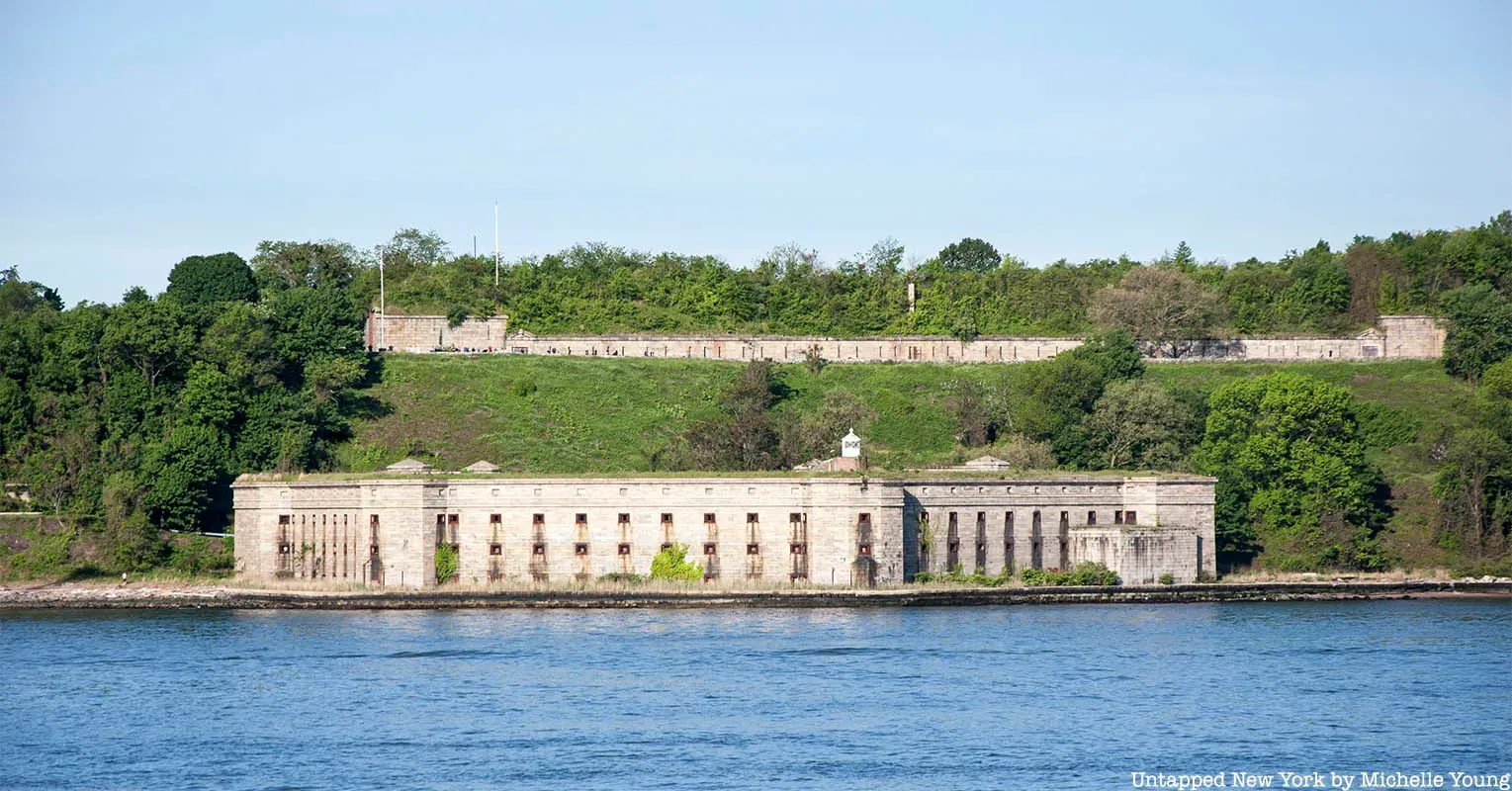
In 1826, a lighthouse was erected near Fort Tompkins. The only problem was, the proximity to the fort meant that practice artillery often hit and broke the lantern. In 1873 a quite fanciful lighthouse and tower were built a little further away to replace it. Now the issue was that the light was too far inland to be effective. In 1901, Congress approved plans to move the lighthouse to the Battery Weed at Fort Wadsworth.
Stretching out along the shore of Staten Island across more than 226 acres, Fort Wadsworth is one of the oldest military installations in the country. Located at the Narrows of New York Harbor, where the Upper and Lower New York Bay meet, the site was strategic in wartime. It was first fortified by the British, who held onto it throughout the Revolution, and then it was used through the War of 1812 and the Civil War. The new light at the top of the battery went into operation in 1903. Like the Little Red Lighthouse, the Battery Weed beacon became obsolete with the building of a bridge, the Verrazano Narrows Bridge in this case. It is now run by the National Park Service.
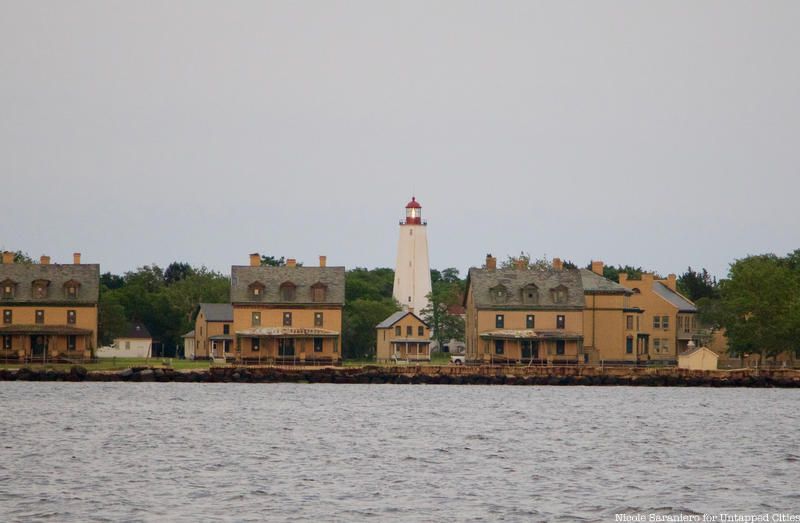
The Sandy Hook Lighthouse in New Jersey is the oldest continuously operating lighthouse in the United States. Serving as the entryway into New York Harbor, the lighthouse was built in 1764 on Sandy Hook, a stretch of land which juts out dangerously (for ships) into the Atlantic Ocean.
In order to help pay for the purchase of land and construction of the lighthouse a lottery was held. 10,000 tickets were but the profit didn’t raise enough money to fun entire project. It did however allow for the purchase of four acres on Sandy Hook from its current owners at the time, Esik and Richard Hartshorne. A second lottery raise the remaining funds. Since New Yorkers were the ones to raise the money, it was originally called the New York Lighthouse.
The Sandy Hook Lighthouse was designated as a National Historic Landmark on its bicentennial in 1964 and transferred to the National Park Service in 1996. In 2014 it underwent a restoration and is open to the public for tours. Because of shifting sands, the lighthouse now sits more than a half mile inland from its original spot, and interesting reversal of shore erosion.
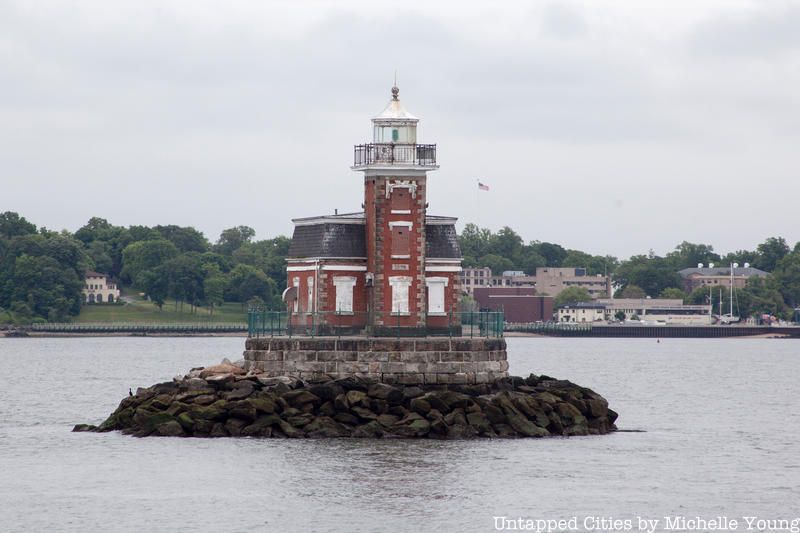
Stepping Stone Lighthouse is one of the most picturesque lighthouses you’ll find in and around New York City. Located in the Long Island Sound near the Throg’s Neck Bridge and Kings Point, the small brick structure with a mansard roof and central tower was built in 1875. The name Stepping Stones possibly derives from Native American legend, with Colonial maps calling this area the “Devil’s Stepping Stones.”
The lighthouse was deemed excess in 2006 and while there is a need for a navigational aid in its spot still, the Second Empire styled house was at risk of being demolished by the Coast Guard and replaced by a simple beacon atop a skeletal tower. In 2014, a group was formed to save the lighthouse and their preservation efforts have been aided by The City Island Nautical Museum. Repairs such as fixing the roof have already been made and hopefully the lighthouse will be restored to its former glory.
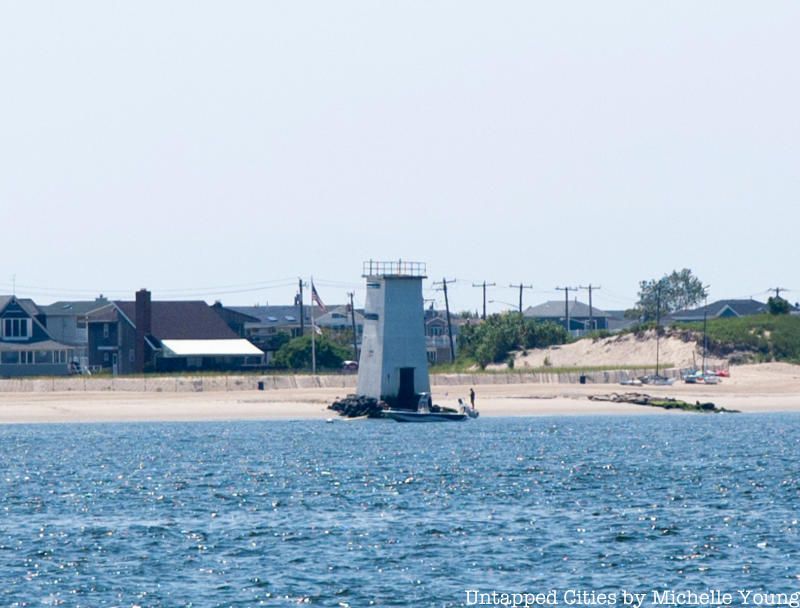
Adopted as a symbol of the Queens community on the western end of the Rockaway Peninsula, the Breezy Point Watchtower only looks like a lighthouse. The fifty-foot structure was built as a look out tower disguised as a lighthouse and was used during World War II to keep an eye on the waters for signs of incoming enemy ships.
The beloved tower was almost torn down in the early 2000s after falling into a state of disrepair. Thankfully, The United States Army Corps of Engineers agreed to take possession and maintain the iconic structure and it was turned into a memorial to Breezy Point residents who served in war.
Driving down the Major Deegan Expressway, a lighthouse is one of the last things you would expect to see, especially atop a building. At 950 University Avenue, the former headquarters of the H.W. Wilson publishing company and now Tuck-It-Away Storage, a small lighthouse juts up above the Bronx skyline. The lighthouse on top of the building was a symbol meant to express the company’s mission of giving guidance to readers navigating different books and publications. The lighthouse was also featured in the publishing company’s logo. It is hard to see from the road, but the lighthouse on the roof actually rest on an opened book.
The publishing company moved out of the building in 2012 and the storage company moved in. The new building tenant kept the lighthouse but put its own stamp on it by painting it orange.
Subscribe to our newsletter